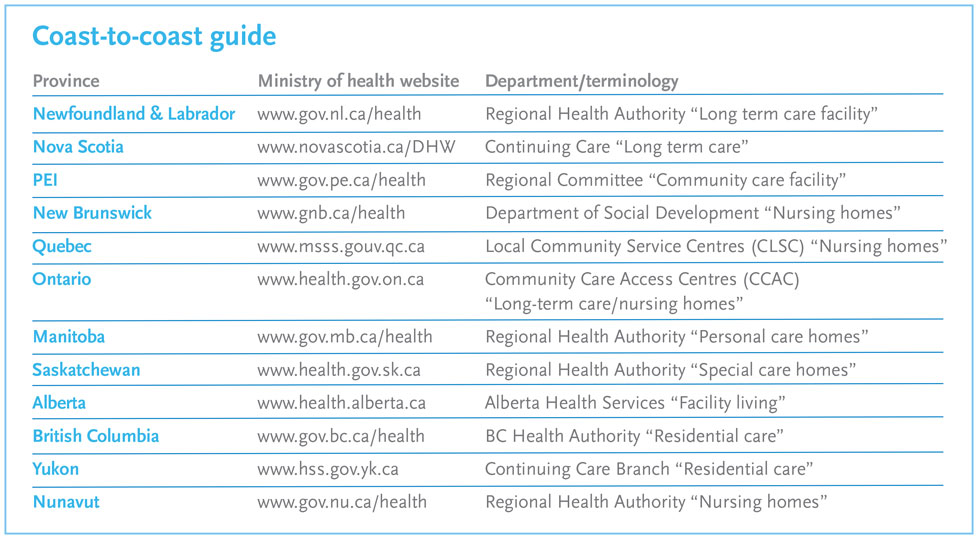Myths, legends or facts? What exactly do you know about nursing homes for your family members? Test your knowledge and see…
By Pat Irwin
 Who qualifies?
Who qualifies?
Myth—A nursing home is the same as a retirement home.
First of all, let’s be clear on what a nursing home is.
Long-term care homes (the term is synonymous with “nursing home”) are for seniors who need help with activities of daily living, access to 24-hour nursing care or supervision in a secure setting. Long-term care homes are licensed or approved by the provincial ministry of health and are monitored by the government to ensure residents receive safe, consistent and high-quality resident-centred care. These are settings where residents should feel at home, be treated with respect and have the supports and services they need for their health and well-being.
Long-term care homes provide higher levels of personal care and support than typically offered by retirement homes, at rates that are subsidized by the government.
Applications to a nursing home must be made through the regional/community care authority. In all provinces except Nunavut, the government pays for care services while residents pay for accommodation and personal items; in Nunavut, there are no fees for nursing homes.
Myth—You won’t get into a nursing home if you have a lot of money or assets
This is a popular belief, but it’s just not true. At present, the ministries of health doesn’t take any account of assets or income unless an applicant is applying for an additional subsidy. Access to long-term care is based solely on health needs.
Myth—You have to sign over your pension, that’s how the home gets paid.
Another myth. Rates for ward, semi-private and private rooms are posted on every provincial health ministry’s website and may be increased every two years. Residents co-pay their portion of accommodation, meals and housekeeping, usually via preauthorized payments (cheques written by the power of attorney or family, in many cases). No pension funds are assigned in to the long-term care home itself.
Choosing a home
Myth –The best homes are always full!
It may be true that your first choice has a waiting list. Homes that are newer, have a cultural attraction or are in certain locations may indeed be more popular. Consider widening your search and keep an open mind. A home may be older but have a great reputation and excellent care. Friends might recommend a place you had never heard of; having a contact there could be an excellent ice-breaker.
Here are some other things to consider when making your choices:
• Is the home geographically close to what’s important to you—the old neighbourhood, family and friends?
• Does it meet your specific cultural, language or religious needs?
• Does the atmosphere seem warm? Are the staff friendly? Do the residents seem happy?
• Do you really need a private room? Some people enjoy the company of others and their visitors.
Newer semi-private rooms are often separated by a shared bathroom, maximizing the private space.
• Do the amenities suit your lifestyle and interests (e.g., suburban versus urban; large and busy versus home-like)?
• Can personal items and furniture be taken in? How about televisions and radios?
• Can specific needs, such as smoking, be accommodated?
Book tours of your selected homes and try to visit at various times of the day. Attend special events and talk to residents and their families about their experiences.
Myth—You can only apply once you’re approved, so why bother to look now?
It is true that applicants must be approved before an application is taken forward. However, research should begin now, before the need is urgent and while you have time to assess the various homes.
 The application process
The application process
Myth—There’s a lot of pointless red tape that gets in the way.
The application process captures the essential information required to assess an applicant and make the most timely and appropriate placement.
To begin, check your province’s ministry of health and its department for senior’s housing (the sidebar will help you). As you can see, provinces vary in the terms used for the community assessment service, and for nursing homes themselves, but the procedures are very similar.
The application will assess various elements of your health and lifestyle, including:
• your need for care and assistance with activities of daily living, such as dressing, bathing, personal care, walking and feeding
• your cognitive ability to make care decisions; if not, a signature will be required from your power of attorney for care
• a health assessment, to be completed by your family doctor, outlining your general health, chronic conditions, medical history and medications
The completed application will be reviewed by the community assessment service and assigned to a caseworker, who will advance it through the waiting-list process.
Myth —You can only choose five homes/you must choose five homes.
The number five is not magic; it’s a suggested number that allows you to make enough choices for a successful placement. If you are only interested in one home, by all means keep your list to one—but be aware that your placement will take longer as a result of this limitation.
Myth—You are ‘punished’ if you don’t take what’s offered.
Once approved, most communities require you to accept any home on your list within 24 hours of a place coming up, and move in within five days. If you refuse that place, you are removed from all lists and cannot apply again for several months.
Managing the waiting list
Myth—A waiting lists mean nothing; if you know someone, you can jump the queue.
Waiting lists can seem illogical, since each home is different. One home may have a small number of private rooms, leading to a longer waiting list. In addition, beds are separated by gender so there can be a longer wait for a male bed; and existing residents get priority, so a spot may be filled internally without ever “going on the market.” Although caseworkers change, the file follows the applicant, not the caseworker.
It is impossible to “jump the queue” except through a crisis placement, which widens your choices. Your caseworker will guide you through this process.
Myth—If you go to a retirement home first, you’ll lose your place
on the waiting list.
This is a common misconception. Where you choose to live, be it at home, in a retirement home or even in a nursing home, has no effect whatsoever on your application status. Many seniors choose to wait-out the waiting list within the support of a retirement community.
Myth—Once you’re in a home, you’re stuck there.
This is again untrue. In fact, choosing a home from a shortlist and later applying to move is a common strategy, especially in urgent cases. Your initial list of choices remains unchanged, so you still stay on the waiting list for your original selections. The shortlist home need not be in the same region as your original choice. Remember: your file moves with you, not with the caseworker.

So, how did you do?
We hope debunking these myths will give you the facts you need to plan successfully!
Pat M. Irwin, BA, AICB, CPCA, is President of ElderCareCanada













